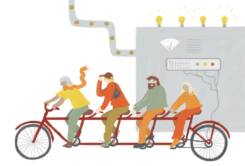Vocational rehabilitation prevents disability
Rehabilitation within the earnings-related pension system means vocational rehabilitation arranged and paid for by authorized pension providers. Its objective is to prevent disability and improve the opportunities for working when a person can no longer continue at his or her former job for health reasons. The intention is that an employee or a self-employed person can continue in working life irrespective of an illness, injury or impairment.
Content of this page
Goal to help coping with working life
The main goal of statutory vocational rehabilitation is to prevent the disability of employees and self-employed persons, thus helping them to cope with working life for a longer time. The purpose of vocational rehabilitation is to prevent a person from retiring on a disability pension, or at least to delay the start of a disability pension. Vocational rehabilitation always takes precedence over disability pension.
Thanks to vocational rehabilitation, the person can
- maintain professional skills and widen competence
- gain better income when compared to a disability pension
- receive a higher old-age pension by continuing to work
- improve the functional capacity and retain the social environment brought about by work.
Seen from the employer’s perspective, vocational rehabilitation supports the employer’s need to manage the personnel’s health-related risks and to ensure sufficient manpower. Vocational rehabilitation supports the extension of careers. At the same time, it reduces the pressure to raise earnings-related pension contributions.
Vocational rehabilitation has close links to working life and the rest of society. It is in the interests of both individuals and society to try to reduce the number of disability pensions. Well-functioning cooperation between the workplace, occupational health care and the pension provider is of primary importance here. The early detection of a problem threatening work ability and the rapid implementation of the necessary treatment and rehabilitation enable an increasing number of individuals to return to working life.
The objective of vocational rehabilitation is that the total costs of rehabilitation remain below the corresponding pension expenditure.
Who is entitled to vocational rehabilitation?
Employees, self-employed people and farmers are all entitled to vocational rehabilitation, provided that they meet the conditions for vocational rehabilitation set by law.
A person who is at risk of retiring on disability pension in the next few years or who is already receiving a fixed-term disability pension, i.e. rehabilitation allowance, is entitled to receive vocational rehabilitation. At risk means a situation where a person’s illness, impairment or injury would lead to the granting of a disability pension without measures for vocational rehabilitation, even if the possibilities for treatment and medical rehabilitation were taken into account.
Another key condition for vocational rehabilitation is that the rehabilitation must be able to prevent or transfer a person’s expected disability for work, or that it must be able to restore work capacity so that the person can continue working or return to work.
Preconditions for granting vocational rehabilitation
The preconditions for granting vocational rehabilitation are defined in pension legislation.
The preconditions for vocational rehabilitation are:
- the applicant has not reached his or her retirement age
- the applicant has been diagnosed as having an illness, impairment or injury which is likely to pose the risk of incapacity for work in the next few years
- the applicant’s earnings from work total at least EUR 42,048.18 (the level in 2025) during the five calendar years preceding the application
- the applicant is not entitled to rehabilitation on the basis of accident insurance or motor liability insurance
- the applicant has employment earnings insured under an earnings-related pensions act in the 36 calendar months preceding the application (time spent to take care of a child under 3 years of age is equated to working when considering employment earnings)
- vocational rehabilitation is appropriate and can support person in continuing to perform work that is appropriate for person’s health condition.
The following factors are taken into account when assessing the appropriateness of vocational rehabilitation:
- the applicant’s age
- the applicant’s occupation and previous activities
- the applicant’s education
- an assessment of whether the vocational rehabilitation is likely to lead to continued employment or return to work appropriate to the applicant’s state of health.
In addition, the assessment of appropriateness takes into account whether the vocational rehabilitation postpones the applicant’s retirement. If retirement is upcoming despite rehabilitation measures, vocational rehabilitation is not appropriate. Rehabilitation must have a saving effect on pension expenditure.
Vocational rehabilitation for persons near the retirement age is dimensioned and arranged so that the person can return to working life after the rehabilitation.
If the application for vocational rehabilitation, submitted by the applicant, is rejected, the grounds for the rejection indicate why the benefit has been denied. If the negative decision is based expressly on medical considerations, the grounds shall state which matters have influenced the assessment of the case and what conclusions have been drawn from them. In addition, the expert doctor involved in the processing of the application must make his own reasoned assessment during the preparation. This assessment will be recorded in the case file.
Applicants may contact their pension provider, either on their own or, for example, through the occupational health service. The rehabilitation experts of pension providers advise and guide the applicant during the planning phase of vocational rehabilitation.
The application for vocational rehabilitation is made by filling out a form designed for this purpose. Granting vocational rehabilitation for a specific training or work trial requires a rehabilitation plan and a B-statement written by a doctor.
However, a rehabilitation plan is not yet needed when applying for rehabilitation. In that case, the applicant can apply for a preliminary ruling on the right to vocational rehabilitation. The preliminary ruling is valid for nine months, during which time the applicant can submit their rehabilitation plan.
Vocational rehabilitation cannot be applied afterwards for rehabilitation that has already begun.
The pension provider also, on its own initiative, establishes the disability pension applicant’s entitlement to vocational rehabilitation. If the conditions for granting are met, the applicant is given both a preliminary ruling on vocational rehabilitation and the ruling on a disability pension. This speeds up people’s access to the necessary rehabilitation. A preliminary decision on the entitlement to vocational rehabilitation is in force for nine months. A decision on the content of the rehabilitation is made after the applicant has presented their rehabilitation plan. A rehabilitation plan can also be declined if the plan cannot be considered as appropriate professional rehabilitation.
Means of vocational rehabilitation
Rehabilitation within the earnings-related pension system is always individual, i.e. its content is tailored to the rehabilitee’s needs and situation. In addition, vocational rehabilitation is always vocational, i.e. it does not include, for example, medical rehabilitation measures.
The key vocational rehabilitation measures are
- guidance and counselling
- work trials at the person’s own workplace or at some other job
- training for work
- supplementing occupational skills or training leading to an occupation
- financial support for operating a business or practising a vocation.
More information about the measures can be found on our page Recommendation on measures reimbursed as vocational rehabilitation:
If rehabilitees have a valid employment contract, it is firstly determined which possibilities their own workplace can offer for rearranging work tasks or making them more suitable for rehabilitees. If the work community participates in the implementation of rehabilitation, it is more likely that the rehabilitation will be successful.
Vocational rehabilitation always focuses on an individual. Group rehabilitation or activities maintaining employees’ well-being at work are not supported as vocational rehabilitation.
Vocational rehabilitation pays off financially
The prevention of disability by means of vocational rehabilitation is financially advantageous for all parties. It is in the individual’s interests to be able to continue in working life as long as possible, also in terms of improved security for old age. In terms of income, rehabilitation is a better alternative than a disability pension.
If the rehabilitee has been prevented from doing gainful employment during the vocational rehabilitation— in full or in part — he or she will be paid a rehabilitation allowance.
The rehabilitation allowance is based on the disability pension to which the rehabilitee would be entitled if he or she were to retire now on a disability pension. This disability pension is increased by a rehabilitation increment of 33 per cent. Together, these make up the rehabilitation allowance.
If the rehabilitee earns more than half of his or her established earnings during rehabilitation, he or she can be paid a partial rehabilitation allowance, which is half of the rehabilitation allowance.
If the employer pays wages for the rehabilitation period, the rehabilitation allowance is paid to the employer.
The rehabilitee can also be paid a rehabilitation allowance in the amount of a disability pension as a discretionary rehabilitation allowance for the period during which a rehabilitation plan is prepared for him or her or for the period between the issuance of the rehabilitation decision and the start of rehabilitation.
If a person receives rehabilitation support and participates in vocational rehabilitation, he or she will not be paid a rehabilitation allowance. Instead, in addition to the rehabilitation allowance, the rehabilitee receives a rehabilitation increment of 33 per cent of the rehabilitation support.
Rehabilitees are reimbursed separately for expenses incurred in rehabilitation, such as travel expenses and study supplies, on the basis of recommendations prepared jointly by the authorized pension providers.
Division of labour in rehabilitation
The authorized pension providers have the primary responsibility for the vocational rehabilitation of people in working life. In general, the pension provider that manages, or has most recently managed, an individual’s earnings-related pension insurance is responsible for the individual’s vocational rehabilitation.
However, rehabilitation under the earnings-related pension system is only one form of vocational rehabilitation. In addition to pension providers, vocational rehabilitation is provided by Kela, the Labour Administration, as well as accident and motor liability insurance companies.
The Social Insurance Institution (Kela) provides vocational training for people who are not entitled to vocational rehabilitation, such as those who have been outside working life for a long time.
Accident insurance and motor liability insurance companies are responsible for rehabilitation when the need for rehabilitation arises from an occupational accident, an occupational disease or a traffic accident.
The employment and economic development authorities provide rehabilitation for jobseekers with disabilities.
Together with Kela, the health services provide medical rehabilitation that supports vocational rehabilitation.
Thus, many bodies are responsible for rehabilitation. It is therefore important that there are clear rules between the various actors. They ensure that each individual’s access to rehabilitation is as smooth as possible.

